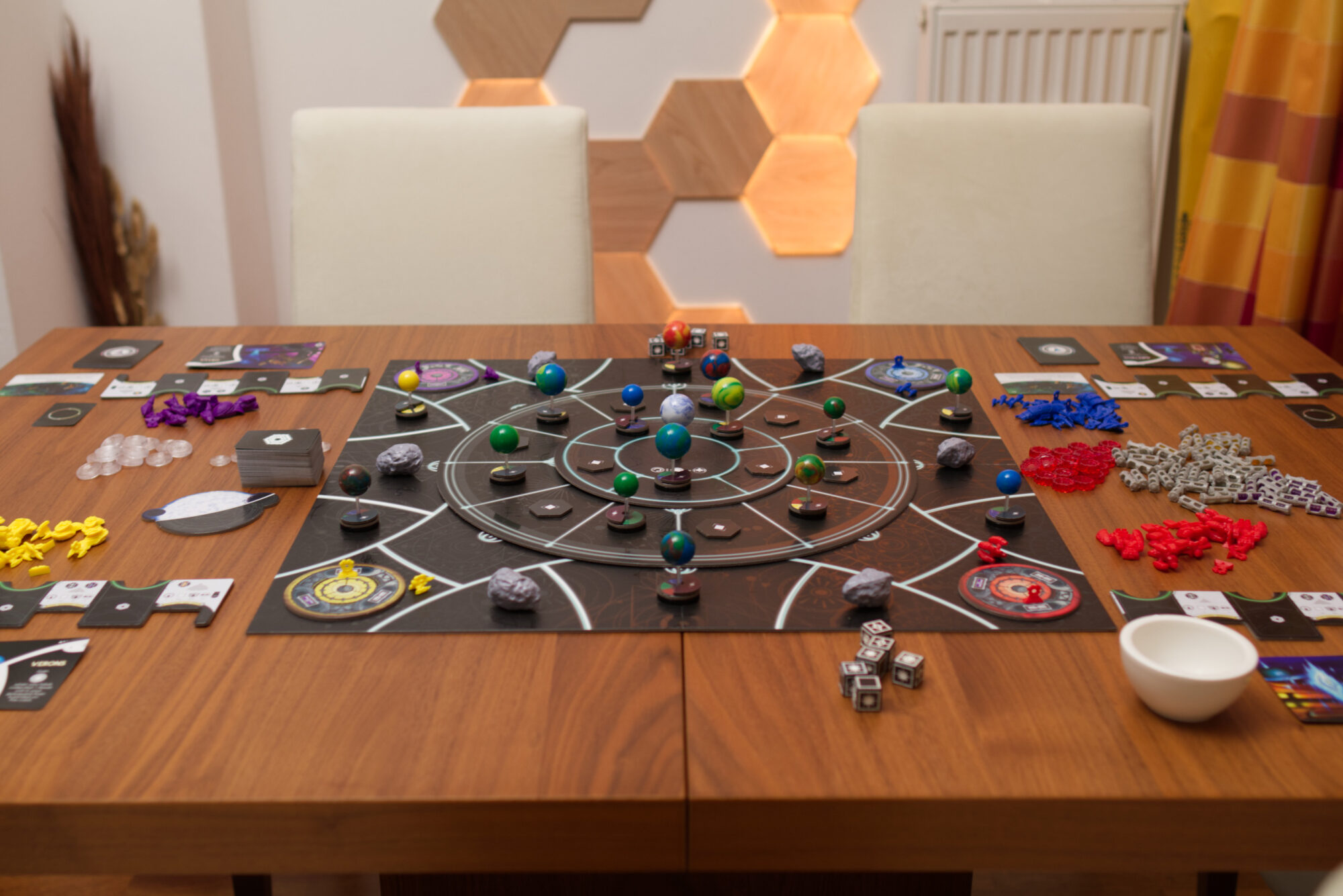There are many good reasons to be interested in a board game: a unique mechanism that hasn’t been seen before, a great theme, a designer one really enjoys. From the top of my head, I can’t think of a game where the outstanding feature that intrigued me was its play length, but that’s exactly what happened with Last Light: a 4x-like space game that can be played in 60 minutes? Now that sounds exciting!
There are a couple of holy grails in game design, like that epic two hour civilisation game many have tried to create (and no, Mosaic unfortunately wasn’t it). I would venture to say a fast paced 4x is right up there next to that. Epic battles, powering up ships with new tech, exploring unknown areas of space in hope of them serving as a stronghold from which to push back the opposition … there’s much to love about 4x games. Unfortunately, to produce that epic feel, they all require an equally epic amount of time, which is what has mostly kept me from playing Twilight Imperium, Eclipse and their likes. I still remember playing Stellar Conquest once ages ago and we played all day. At least 1/3 of that time we each didn’t have any contact to other players on the board if memory serves me right. It was awesome!
Of course I tried Voidfall and Beyond the Sun, but they feel like they are rather playing in a different category and only utilise the space theme. Last Light on the other hand looked like it might just be able to succeed in capturing that spirit of 4x, so I was intrigued and spent a for me unusually high amount of money for the Deluxe Edition plus 5-8 expansion. I can probably count on one hand the number of times I have played with 5+ players in the last couple of years, but oh well, I was hooked! Now that it has fulfilled, it’s time to see what’s what…
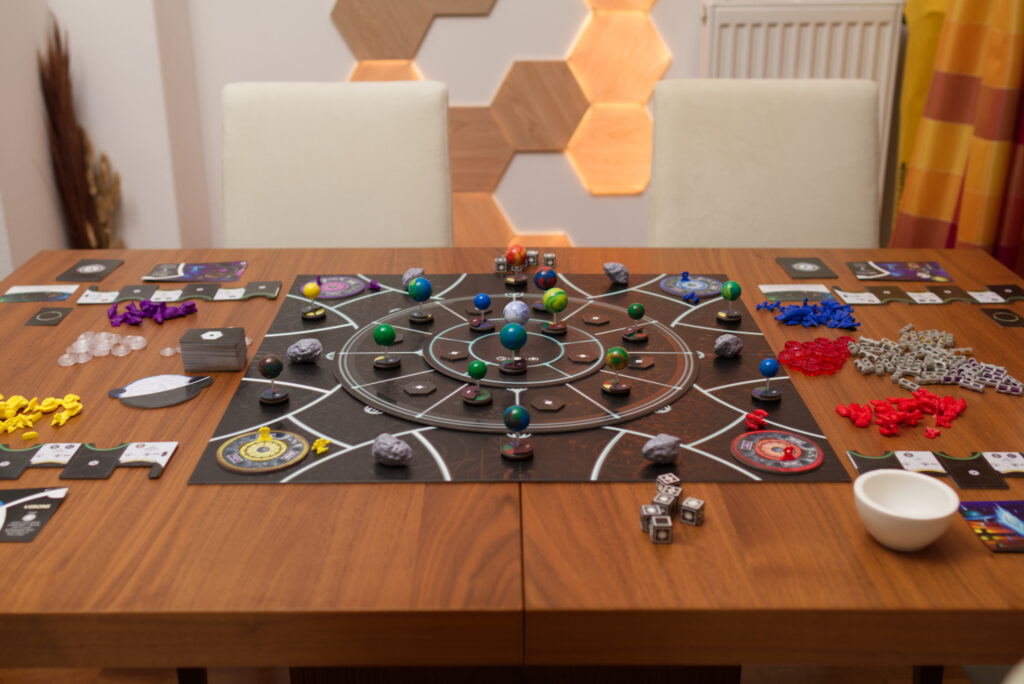
Unboxing & Setup
My unboxing experience of Last Light unfortunately set me off to a bad start. Due to insufficient packaging, the box already came pre-dinged and the publisher rejected sending a replacement box. Considering the substantial size of the box (an oversized Ticket to Ride box, similar to the deluxe edition of La Granja or Suburbia), I can kind of understand that. But still, it’s not what you want from a 200€+ product.
Inside the box, we’ll find a rather unusual main board that has to be assembled and disassembled every time one plays by sticking a pin through the bottom and then placing two folded discs on it. The whole thing is topped off by placing the dying white star that produces the titular last light on top of it. The Deluxe Edition uses some UV coating that produces interesting spirals in the board when light hits it at the right angle. My first play was in the evening and in that lighting situation, the effect of it felt a bit weak. But during day time, it looks pretty tasty indeed!
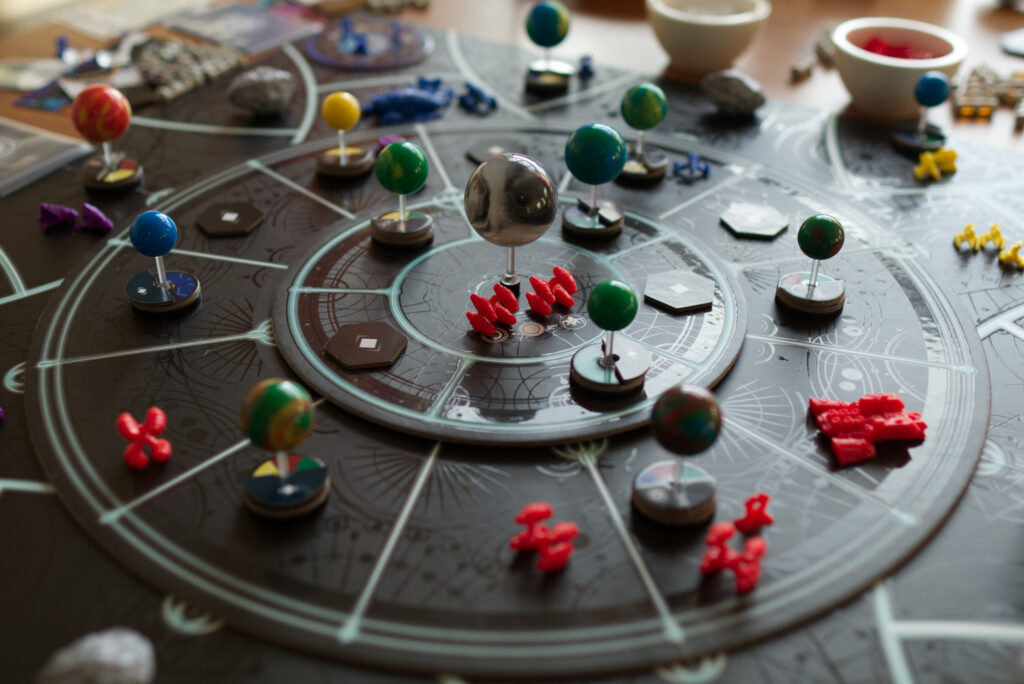
Next in the box is a half-filled tray of planets, spheres that look like plastic marbles on top of a transparent pin and a black base. As I understand it, the tray is only half filled in case one wants to add the planets of the 5-8 player expansion into the base box. I have a pet peeve of half empty trays ever since I reviewed Shogun no Katana as it always feels like an attempt to upsell. The planets themselves look quite nicely, though the manufacturing process does seem to have had its challenges. Yellow and blue planets naturally develop some green in them although the planet in-game only counts as blue-yellow. Even worse, one of my blue-green planets hardly shows any green at all. Perhaps as a way to compensate this and also make the game accessible for players with reduced colour perception, the game comes with a set of cardboard discs that are placed on top of the base before the pin is stuck into it. While functional, it kind of destroys the others lovely aesthetic of the board a bit. I briefly tried playing without them and it looks much better, but the spheres alone are not enough to identify the planet’s colours reliably – especially in sub-optimal lighting situations.
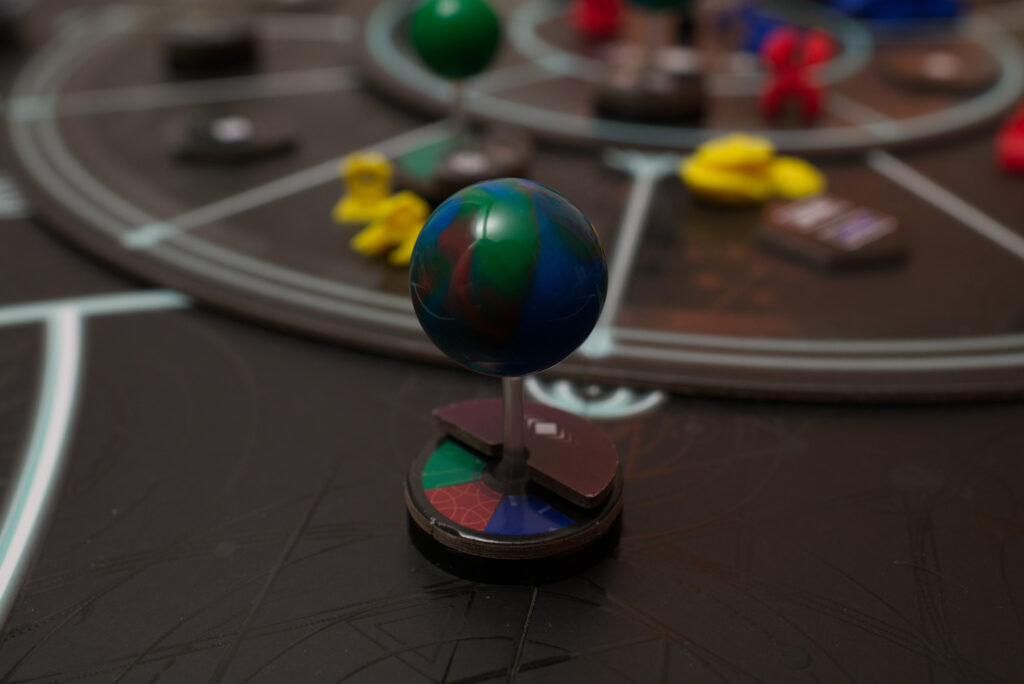
The tray itself is unfortunately not only half empty but also rather non-functional. It feels like the shrinking process of the plastic wasn’t accounted for or something like that because planets take considerable force to push in to their slots to not pop out again and for some, even with force they don’t lay flush. The transparent plastic lit thus not only doesn’t stay on (which makes it difficult to close the game box) but in my case also is so thin it already has a tear in it. For full transparency, that is something the publisher did indeed offer to replace, unlike the box and that virtually completely blue planet I have that was supposed to be blue-green.
Under the tray is a somewhat odd insert that was clearly designed in the hope backers would buy the optional player trays. So in my case packed in loose zip-lock bags, it houses the ship minis (different moods for each player color), resources, asteroids and various other bits and bops.
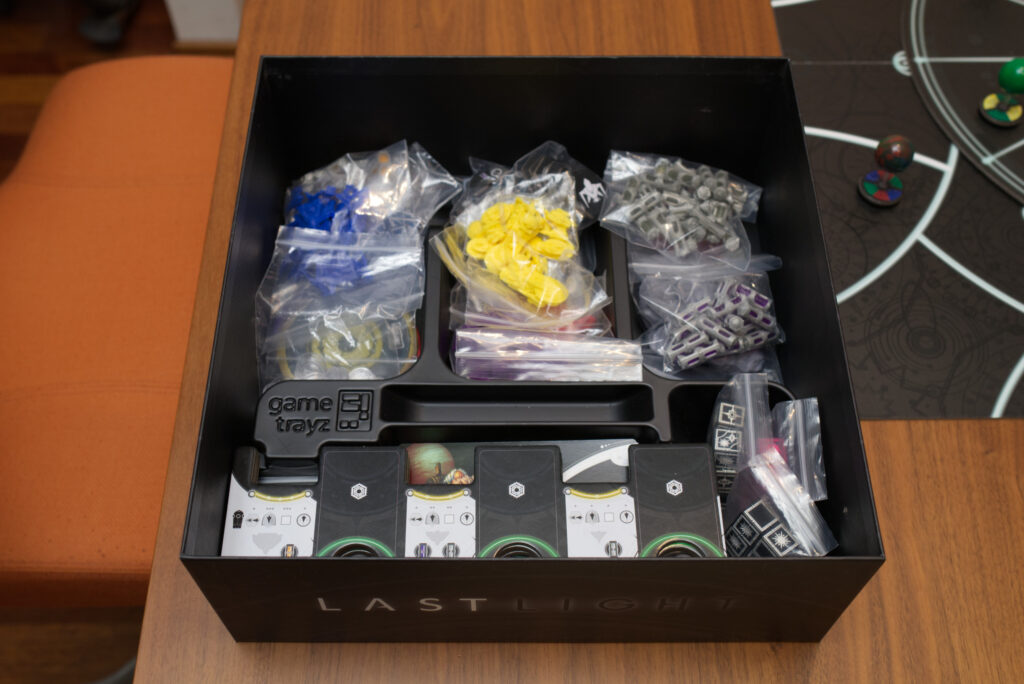
Setting up Last Light is done rather quickly. Each player gets all minis of their colour, chooses one of the many alien factions (=unique player power), a board representing the three classes of ships with slots for tech upgrades, a grey (=lowest value) resource, a set of 6 action cards and a set of four planetary achievement cards. The latter shows the four colours planets can be in and are basically a self-chosen secret agenda to conquer a certain number of planets with that colour for extra VP.
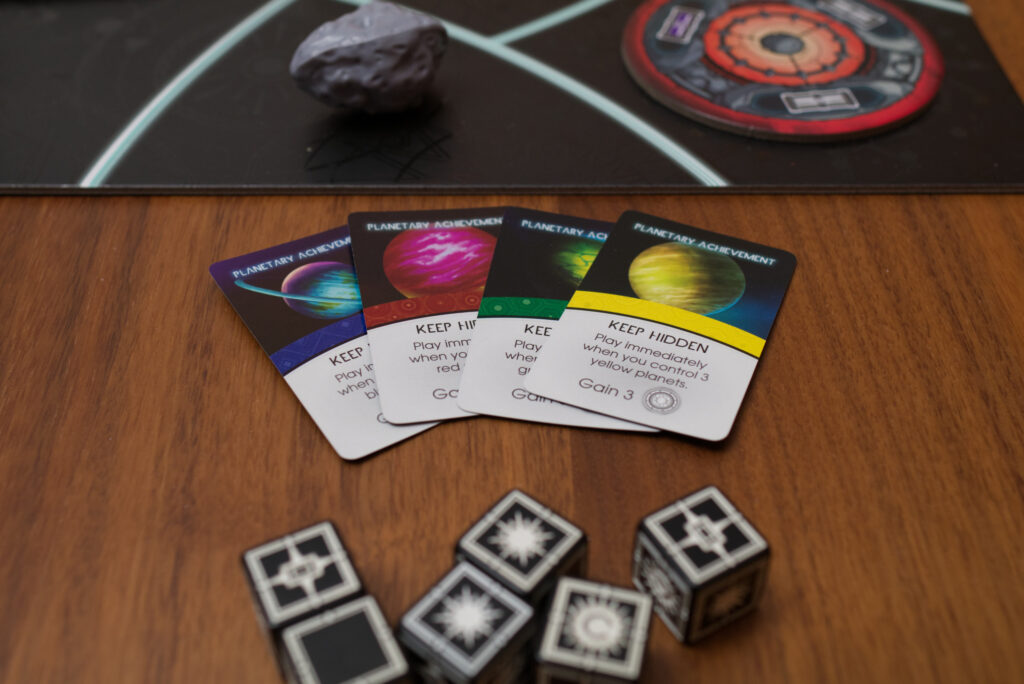
The actual board setup is dependent on player count and shown in the rules. Each player has a large, indestructible colony ship (a big cardboard disc) that stays in a fixed position for the whole game. This is where players will produce and launch their ships from. Next to their colony ship, each player has a sector with a so called distant planet, basically something that is too far away for other players to be really concerned with and thus in relative safety. There are also asteroids placed in certain sectors to block off parts of the board depending on player count. These are quite large plastic bits that don’t match the size of the planets at all and thus look a bit displaced on the board. I think having these in cardboard and to scale like in Stars of Akarios would have looked much better. Or at least use multiple smaller asteroids to fill the sector.
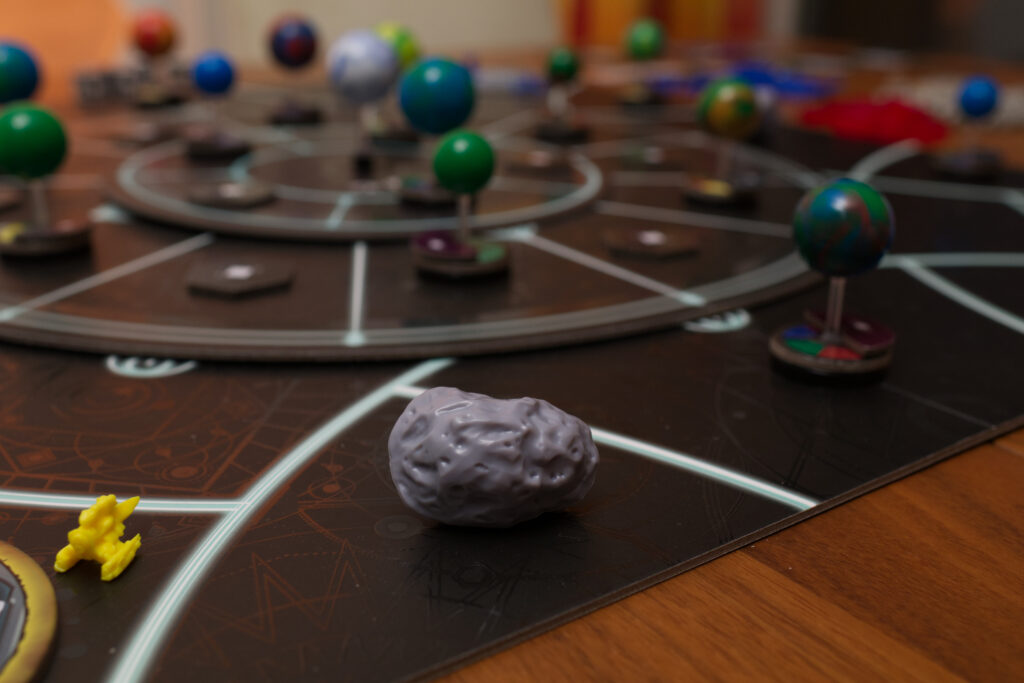
The larger disc in the centre is filled with planets and deep space exploration tokens, one time bonuses for the first player to stop in that sector. Same for the inner disc, but they differ in one crucial aspect: all planets on the board get a half-circle cardboard piece placed face down on their base. These come in two varieties and show on their front side what type of resource the planet produces and what the one time bonus for exploring the planet is. Planets on the inner disc provide better bonuses than those on the outer disc. To give you an example, outer planets typically produce a grey or purple resource, while inner ones often produce gold resources (needed to build the largest class of ships) or even straight up victory points.
Upon reading the rules, you – same as me – might be wondering how exactly it is decided which of the planets is placed where, to which the rules reply: YOLO it! Just place them at random, which seems quite odd when one player might end up with a multi-colour planet as distant planet right in front of their door step and someone else gets a single colour planet that limits what planetary achievement makes sense for them. For all other planets though it doesn’t really matter that much as the party piece of Last Light is its revolving game board. During certain moments in the game, both discs are rotated 45 and 90 degrees respectively, making the board highly dynamic and turtling an impossibility.
Overall, setup of Last Light is rather quick and no strenuous sorting of cards or such things is involved. Setting up the planets and the rest of the board is probably largest part of it.
The Turn
The thing that makes a session of Last Light possible in around 60-90min is that its action selection mechanism in large parts can be processed in parallel. Each player simultaneously chooses one of their yet unused action cards, indicates they are done and then all players reveal their card and place it on top of their personal discard pile. Each action has a number from 1 to 6 on them which technically indicates in which phase/order they would be executed. However, except for card 6 (Command), they don’t really affect what others are doing. So in practice everybody does their thing and then all players that played the Command action then perform movement in turn order followed by any resulting combat happening in parallel.
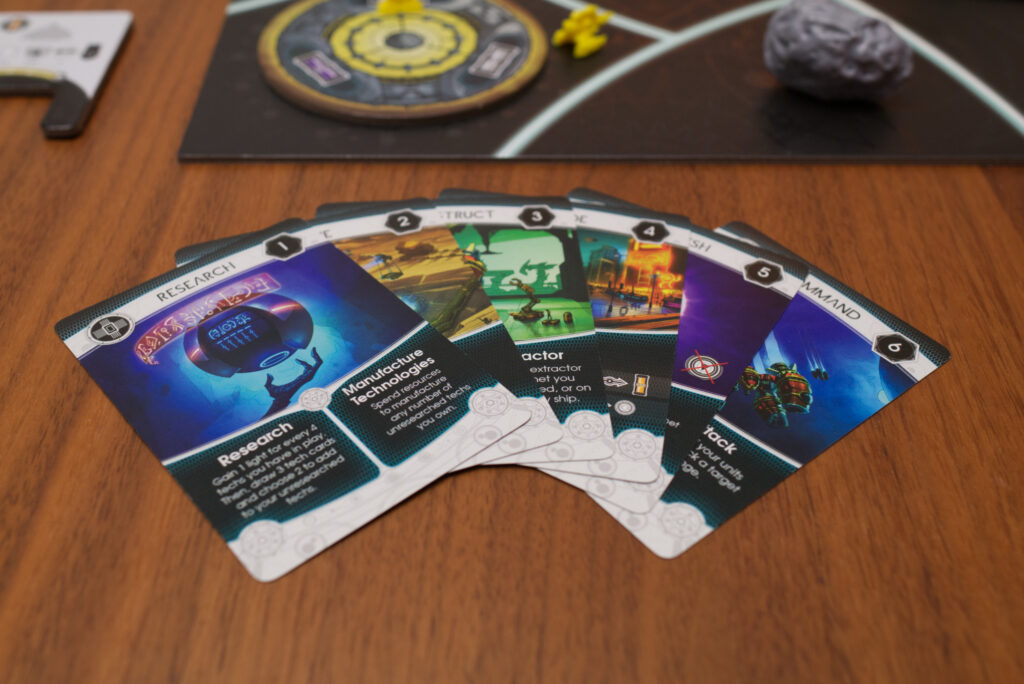
There is one caveat though: some technology cards offer functions that can be exhausted by flipping the card and their effect happens with the timing of their players action. As a consequence, it can happen that someone might be able to move ships or do something else that affects others although they technically are in an earlier phase of the round. In general though, this never really was much of a problem for us.
Very briefly put, the available actions allow for researching new tech, produce resources on planets a player controls, build new ships and extractors (pieces that are placed on planets to control them), trade resources with the bank, refresh their card hand (similar to taking back cards via the Tribune in Concordia), and the aforementioned Command to move and attack.
Instead of going through the actions in detail, let me rather describe the pace of the game and decisions to be made. The start is usually a rush towards the centre as exploration bonuses can give a player a huge boost to their early-game economy. Being efficient is of outermost importance here as ship speed is rather slow: only a single sector, unless one has managed to get a copy of a very specific tech upgrade. The only other way to speed up movement is to use the Refresh action to get a spent Command action back early, but that basically costs that player a turn. Most importantly the Refresh card itself is not picked back up but stays in the discard pile. Only once the last player has played their Refresh card are all players allowed to take back their Refresh but NOT the rest of their discarded actions. To do that, a player has to play their own Refresh card. This simple mechanism rather quickly puts players into different cycles and causes interaction as players constantly check which player can still play a Command or has it already spent.
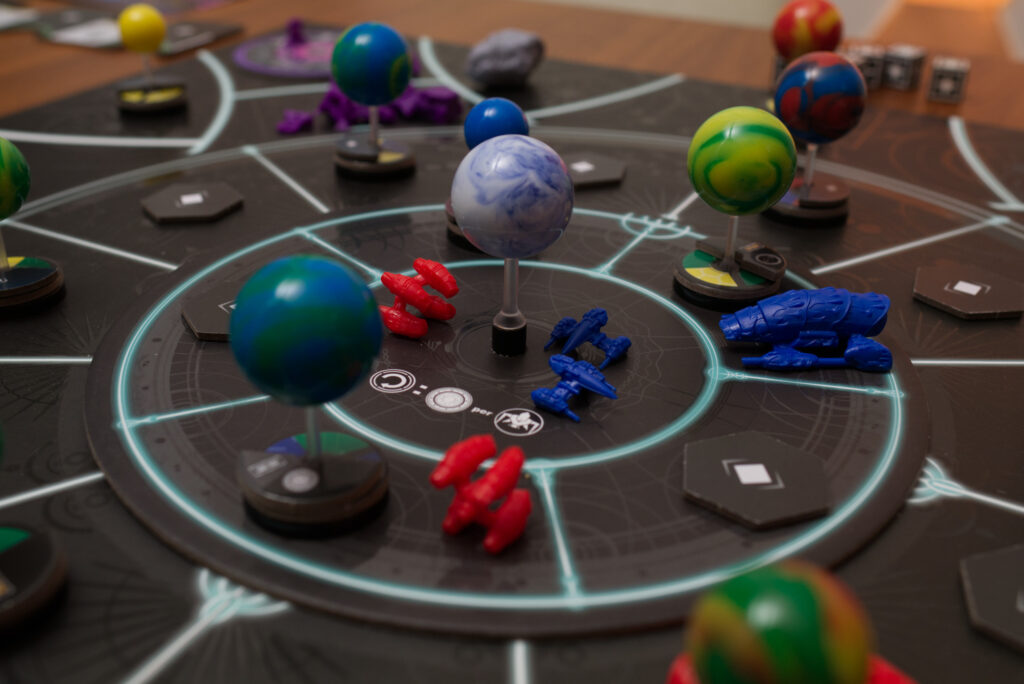
Once all players have played their Refresh card, an additional end-of-round effect is triggered: the discs on the board are rotated with everything on top of them and each player receives one light (the victory points of the game) per ship they have in the very centre of the board. This is yet another mechanism that naturally draws players towards a head-front collision in the centre. If that wouldn’t be enough, each player also has a graveyard where they collect enemy ships they destroyed and those can be converted to VP as well.
So the general vibe of Last Light is: go fast, grab what you can, build more and bigger ships quickly, and try to shoot down as many of your opponents’ ships as you can while claiming the centre as well as planets for yourself. Forget about defending planets and such, it usually is much more profitable to go hunting somewhere else. In that sense Last Light reminded me of Empires of the Void II, a game where it’s also difficult and often not worth it to persist on keeping ownership of certain planets. It’s not uncommon in Last Light to fly into one sector to hunt an opponent and them just moving out of it because they also played Command and are after you in turn order.
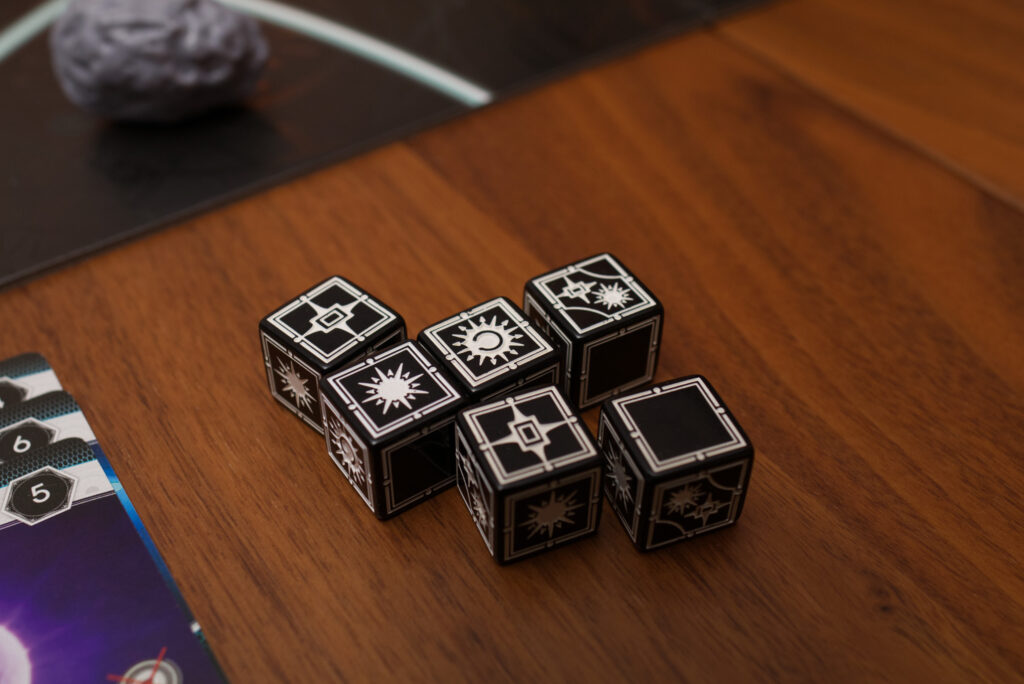
Combat
So let’s talk about combat: each of the three ship types has a certain number of dice and hit points. If ships face off, take the appropriate number of dice, role them and count the number of hit symbols. The custom dice show a miss, normal hits, hits that allow you to role additional dice, and symbols that activate tech cards the ship type might be equipped with. For each hit, a ship gets a hit marker up to the number of health points the ship has before it is destroyed. Speaking of which: playing the Refresh action as a side effect also repairs all ships and refreshes all of their exhaustible technology cards.
The most important part here is: ships don’t auto-defend! Unless the attacked player also played a Command card that round, their ships are dead in the water. There is this constant double-think of whether the other player might or might not play a Command or do an early Refresh to get theirs back before you do yours. It’s a simple mind game but it’s a fun one that further helps to spice up the game. There are of course techs that can enhance the combat capabilities of your ships, but this doesn’t play as essential a role than in other 4x games. It’s quite common that the game ends and some of your ship classes don’t have any upgrades at all.
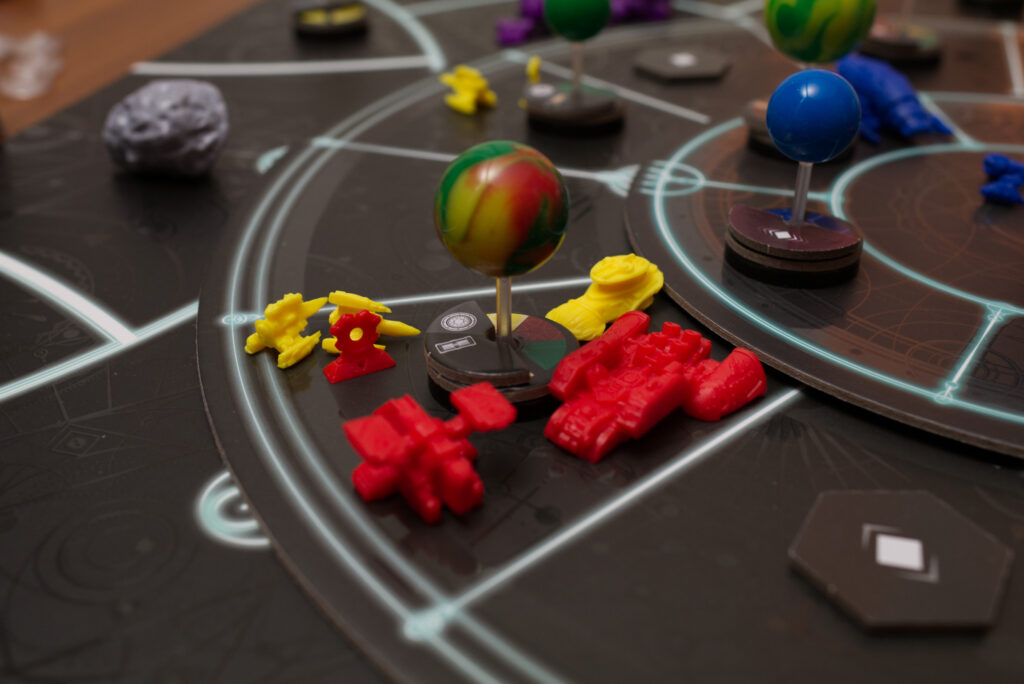
Technology
So let’s speak about those upgrades. In Last Light, there are three classes of tech: blue ones that affect your whole civilisation, green ones that affect a specific ship type and typically only activate when rolling the tech symbol in battle, and orange ship mods that permanently boost up the associated ship type. Techs range from very simple things to powerful cards like extended firing range, speed, or something that produces a gold resource, the most valuable thing in Last Light besides light itself. Each card has a cost of 1-2 resources of varying colours printed on them.
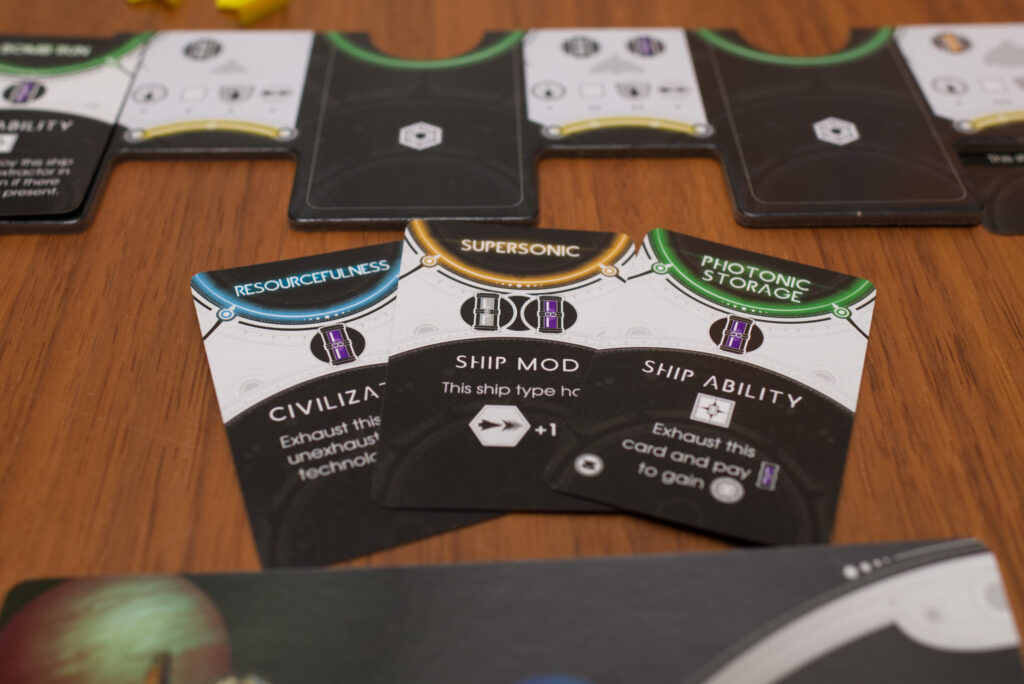
The tech system in Last Light is rather straight forward. There are no prerequisites or tech trees, the only thing to remark is that the number of ships mod that can be equipped is different for each type of ship. While small ships can only hold a single mod, the large ships can hold up to three. But the number of ships is limited and so a player can only create 5 small ships, 3 mid size ships, and 2 large ships, a limit that one runs into surprisingly often.
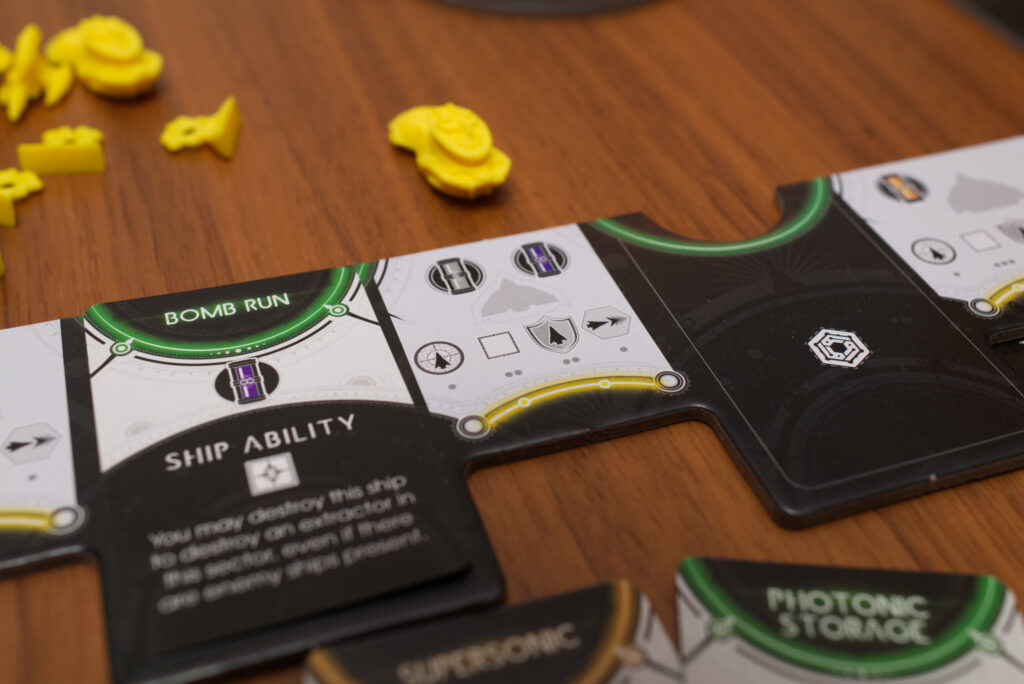
The balance of the techs is kind of an issue, but not a severe one since the game is over so quickly. There are some techs that are far better than others, the sought out favourite in our group being an early-game Supersonic for a speed of 2. This enables grabbing the vital exploration bonuses before any opposition can reach them. Giving the smallest ship class shields or extending the firing range were also among our favourites. However, it all depends on which tech cards one draws. The green ship abilities were often to specific or too difficult to trigger that we mostly build them if we had the resources anyway and were going for a large number of techs.
The Research action tries to address the imbalances by allowing to draw 3 techs from which to keep 2. The other aspect that might or might not be worth pursuing is building lots of very cheap techs as the Research action generates 1 VP per 4 tech one already owns. Overall though, producing ships quickly, claiming planets, and going into battle seemed to have much more of an impact than getting any particular tech. But without techs, it was also difficult to persevere for long against an opponent that had boosted up their ships.
The Resource Economy
Last Light is all about ship-to-ship battles and both technologies and the resource economy are just a means to dominate in the former. Each player starts off with a single extractor (yet another type of mini) on their colony ship that produces a grey resource, the cheapest of the three resource types (grey, purple, gold). Every time the Construct action is used, the player not only gets to build as many ships as they can afford but also place a single extractor for free on a planet they alone are in orbit of. During Mining, all planets with an extractor will produce their resource and during Refresh, planets on the inner and outer disc produce victory points unless they have enemy ships in orbit.
The fact that extractors are free and limited to one per Construct action gives Last Light an interesting vibe. It keeps the game’s focus on the battles but gives the players another motivation to fight over planets. It’s surprisingly painful to have to play Construct because one needs new ships but not have a new planet on which to place an extractor. The players are thus incentivised to free some new planet from enemy ships so they can build an extractor next time the Construct card comes up for them.
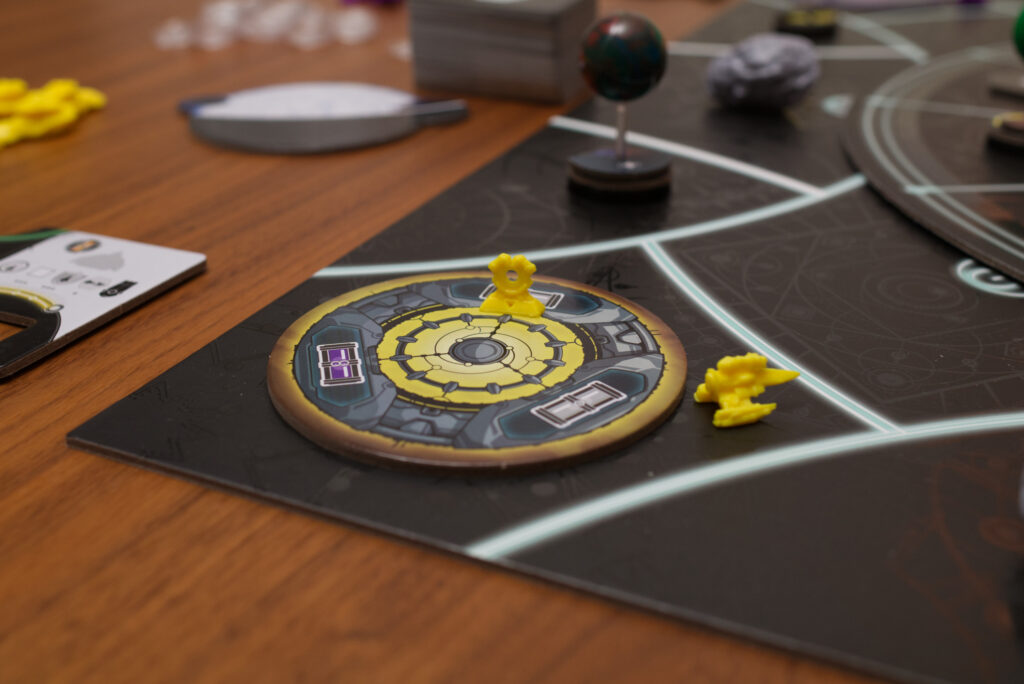
Another interesting design decision here is that once someone has placed an extractor on a planet, it is quite difficult to remove it. By default, only the largest class of ships can destroy extractors, and there is only one tech that allows equipping other ship types with this capability. Combined with the fact that even if a planet has enemy ships in orbit it still produces resources, it produces a dynamic where one doesn’t really care that much about removing enemy extractors. It’s simply too slow and too much effort and usually much easier to rather claim an empty planet or place ships in the centre to produce VP directly.
Still, it is important to wrap up one’s own production quickly, ideally even with a source of golden resources, as otherwise it will be difficult to compete with the ever growing armada of enemy ships.
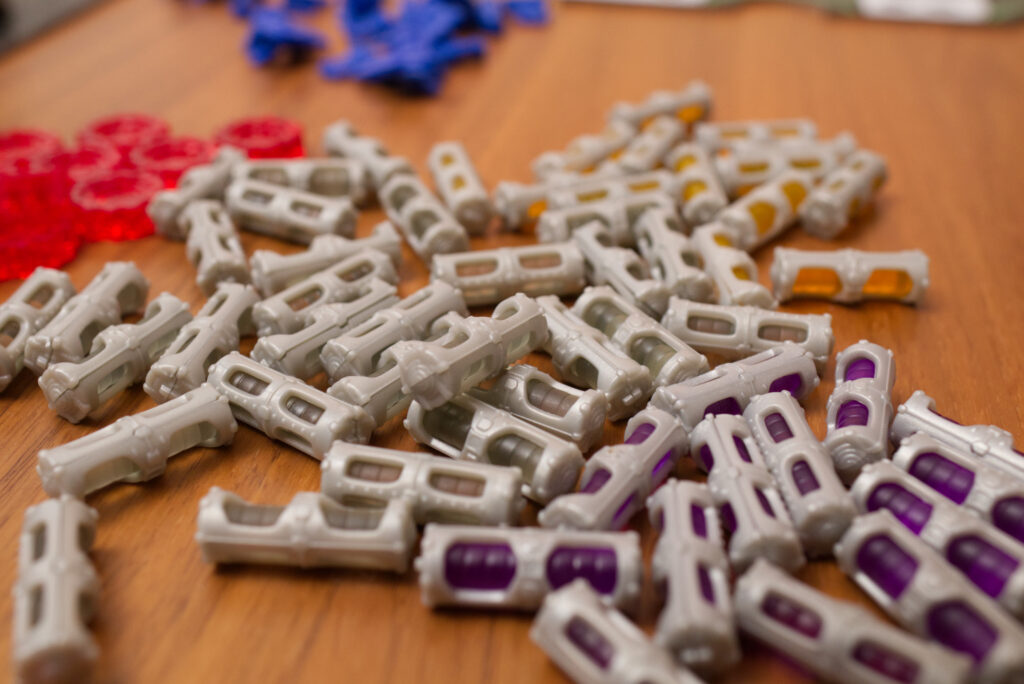
Game End
The game ends when a player has earned 20 light, it’s as simple as that sounds. It has to be stressed though how much of an efficiency race Last Light is. Having a few well placed planets under one’s control can mean a single use of the Refresh card can produce 4-5 light alone. For someone to have 3 or so ships in the centre when the board turns is also quite common, again producing light. Gaining VP via a large number of tech seems to be more of a small welcomed bonus than anything to base your strategy on, though getting VP by getting large number of enemy ships into your graveyard can have a serious impact. What also seemed to be quite popular is to claim control of inner-disc planets that produce light during mining.
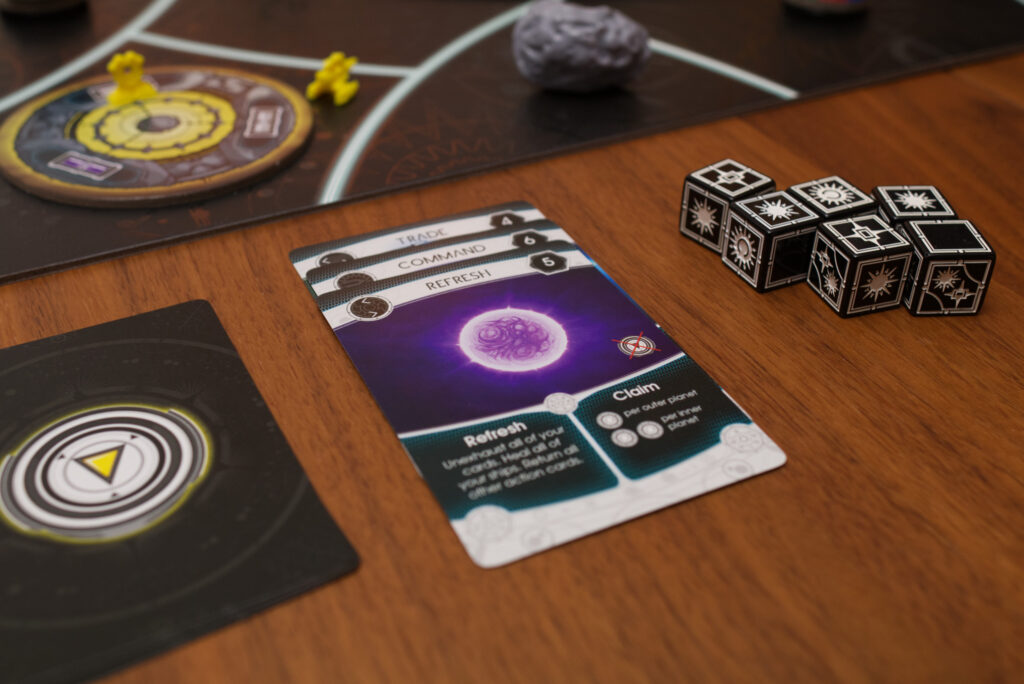
In general the arc of our plays can best be described as a quick rush to produce more ships and grab as many exploration bonuses as possible while trying to not waste any chance to place an extractor on a planet. That was followed by a phase where it is all about moving and destroying ships while trying to produce enough resources to keep one’s own production of ships high. As mentioned before, it can quickly happen that one runs out of ship minis to produce. The Trade and Research actions played more of a support role with Mine-Construct-Command-Refresh formed the core loop.
Player Count
The base game of Last Light is designed for 2-4 players. I was quite disappointed that somewhere during development the solo mode was scrapped, but apparently the results weren’t up to the designer’s expectations. I made an attempt to create my own automa that can also be used for adding more factions in a 2-3 player setup and I think it turned out quite nicely. It’s not quite competitive enough without giving it additional bonuses (e.g. extra VP or ships), but enjoyable to play against. You can find it here: Last Light Solo Mode
For two players, Last Light uses a special variant which introduces a third party that is controlled by the player with the fewer VP. Every time the board is rotated, that party gets two additional ships which increase in size as the game comes closer to its end. It seemed to work okay but produces some odd situations where we intentionally avoided gaining an extra light to be able to keep control of that faction. If you are planning to play Last Light primarily with 2 players, just be aware that you’re not getting the full experience.
I never had a chance to actually use my 5-8 player expansion, but the way the game is designed, I don’t see any issues playing with six or even more players.
Deluxe Production
Since this is a Deluxe Edition and quite a pricy product, let me quickly talk about the production. On the plus side, the main board is pretty damn cool! What also surprised me was how many different alien factions are included in the game. The minis also look good, although with the purple minis it’s a bit tricky to distinguish the small and mid size ships. On the other hand, the small red ships are as big as some mid-size ships in other colours. And one of the colours in the 5-8 expansion looks quite similar to one in the base game. What is a bit odd is the mixture of the vibrant-coloured colony ships as cardboard and the plastic minis for ships. It would have been great if the colony ship could also have been a mini of sorts. The light tokens I also liked quite a bit, although the 1 and 5 are not as clearly distinguishable from a distance as I would have like them to be.
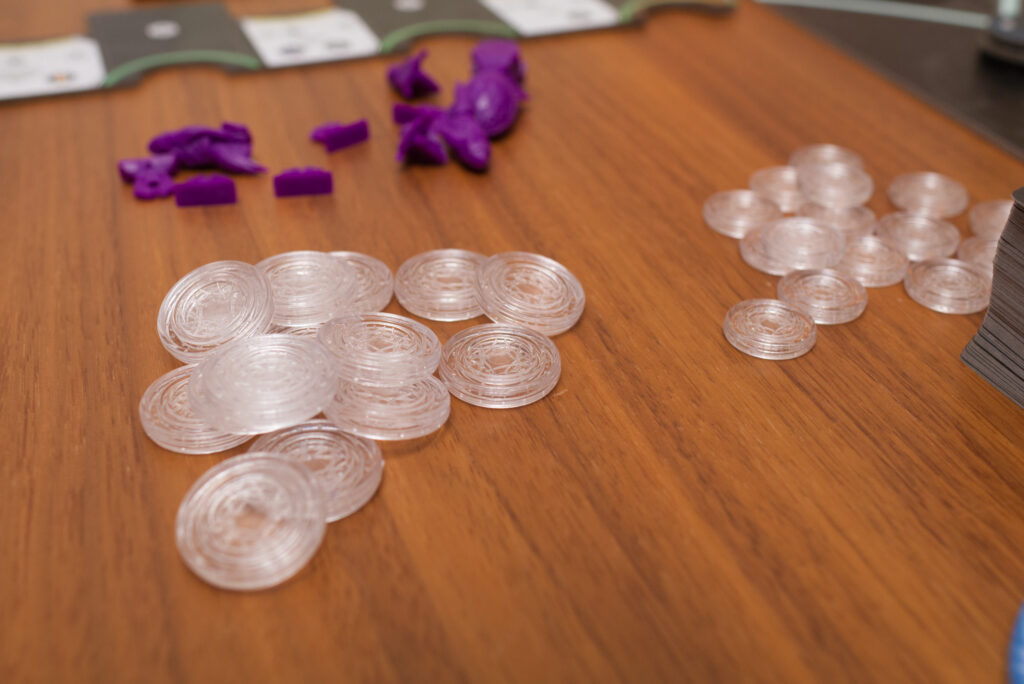
As said before, the planets look cool but some people might have slight issues with them as it can be difficult to identify a planet’s colours just by looking at the sphere. The tray and inserts I found quite disappointing. The asteroids are too large for my taste and look cheap, the grey (=transparent) resources on my walnut table are quite hard to distinguish from the gold resources and have led to mix ups multiple times. However, the biggest disappointment for me are the damage tokens. They to me look plain ugly and are completely impractical. I wished they had been simply cardboard so one could at least have stacked them underneath the ship that they belong to. Imagine having a large-size ship with two damages and trying to move that to another sector. The just feel wrong and look weird.
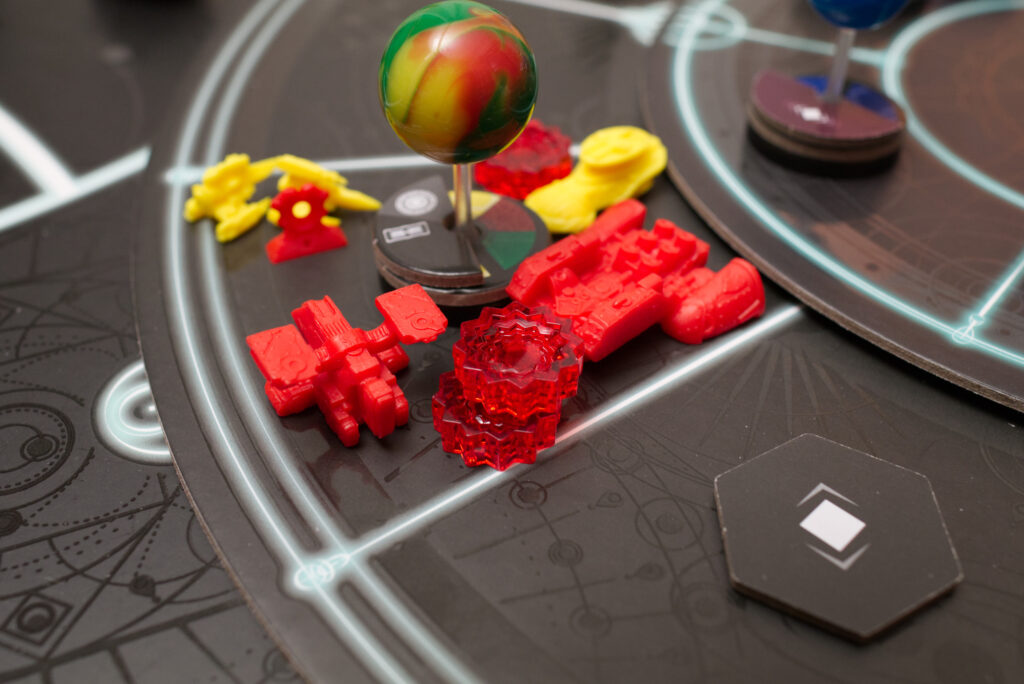
Overall, this is an odd production. It feels to me like an even bigger production was originally envisioned but then some cost cuts had to be made to stay somewhat reasonable. On the one hand, the board looks great and there are lots of individual minis, on the other hand some of the cardboard tokens and the underside of the main board already look scuffed up like I would have played the game for multiple years. It leaves a light aftertaste of “designed for crowd funding renders” with me. This is most apparent with the extra set of dice I ordered that looked very cool on the page and rather cheap in person.
The rulebook also makes things more difficult than need to be, with crucial information hidden in parts that look like side notes. Also the rules are a bit ambiguous whether or not extractors on the colony ship produce one resources or two. The correct answer here is one, but the design of the colony ship as well as the image in the rules looks like it would be two.
Considering the price and the mix of cardboard and minis, Last Light might be one of those cases where I might actually prefer the retail version. But I unfortunately didn’t have the chance to see a non-deluxe version, so I cannot really comment.
Conclusion
I’m quite torn when it comes to Last Light. I guess a good start is to congratulate Roy Cannaday because there is a remarkable amount of interesting design decisions in this game, especially for a first time designer: ships don’t auto-defend, extractors are free and limited to one per Construct action, severely limiting the max number of ships per player, the rotation board that prevents turtling, … it really feels like Roy had a clear vision of what type of game he wanted to create and tweaked each individual part to contribute to that overall feeling. Last Light isn’t about having the biggest resource production or most advanced tech, it’s all focused on rushing towards the middle and jumping into conflicts. It reminded me of a documentation I saw on the reboot of the PC franchise Doom where one of the designers mentioned they had seen in playtest sessions that players would hide behind corners and in general tried to avoid risks, which was why they added power-ups spawning out of defeated enemies so players were forced to stay in close combat action. There is no real economic or tech path to win Last Light, it’s all about being fast and being efficient. There is no need to develop deep strategic plans because in a couple of turns time, a large portion of the ships on the map will be gone and it will have rotated anyway.
This of course limits the depth and complexity that Last Light can provide. But it also frees up the game to be fast and fun. In a BGG forum thread, someone asked how Last Light and Voidfall compare and the best image I could come up with was that that is like comparing Stratego to a GMT game: they are polar opposites. I think the discussion of whether or not Last Light is really 4x is pretty much moot, it manages to carve out its own niche in the hobby. Do you like space ships, tech upgrades, fast-paced conflict, a little bit of mind games, and your group is 3+ players? If yes, you will enjoy Last Light, it’s simple as that. If you’re looking for strategic depth, rich economies, tech trees and such, it’s probably not the game you’re looking for.
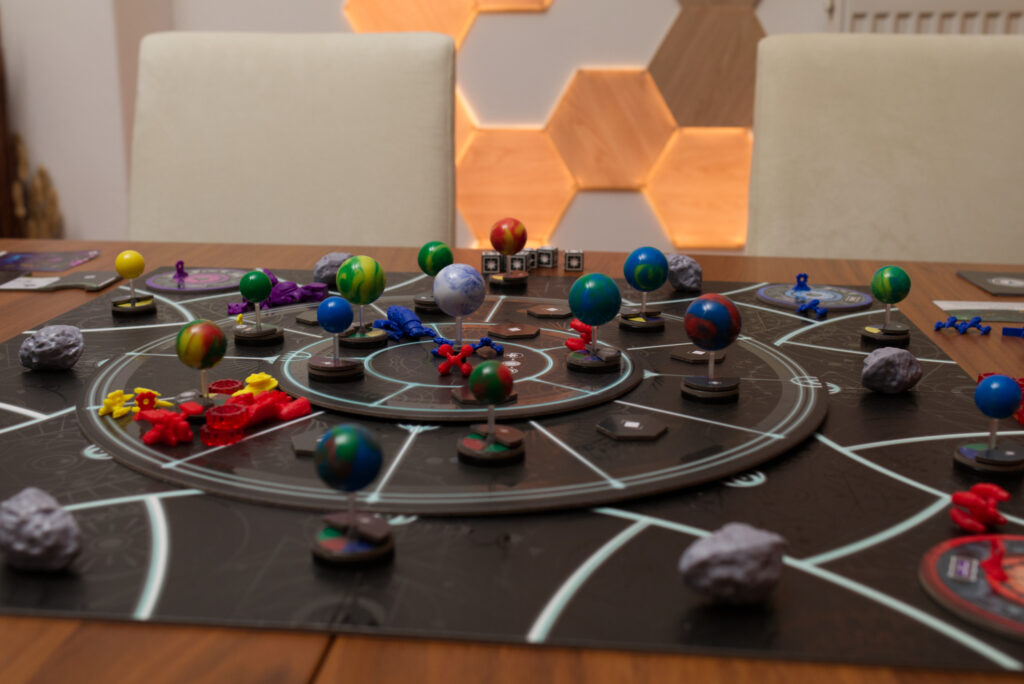
So far I was pretty much on board with Last Light and enjoying it a lot. Having no official solo mode and a somewhat weak 2p mode was a bit of a disappointment, but that can be addressed. There are however two major reasons why this is not staying in my collection … at least not as a Deluxe Edition. It’s another huge box and a pricy one at that, with some production choices that don’t feel very deluxe to me. I like Last Light a lot, but enough to justify that investment in storage space and money? The equation might look different for me when it comes to the retail edition. Sure, I’ll miss the ship minis, but the design of the cardboard tokens is much more consistent to the colony ship and alien factions that are also part of the Deluxe Edition and the cool planets are also part of the retail edition. It might be a case of simply better usability as well if I take into account my issues with the resource and damage tokens.
The other factor that keeps me from keeping my copy is that I doubt I will get it to the table much. Yes, there are tons of alien factions in there, which effect was smaller than I had thought, and so the game quickly developed a routine for me. I’d always play the same opening sequence of actions, only interrupted if I by chance had gotten a particularly juicy tech (such as the extended ship movement) as my starting hand. Think about it: the only variance beside the alien faction (which often don’t have as big an influence as one might think) and the starting tech (a lot of them being rubbish) is the outer planet that’s next to your own colony ship. Everything else on the board is pretty much the same from game to game. The rest of variance is players being hit by varying degrees of good and bad luck when it comes to the exploration bonuses or techs they draw. For example, I one time intentionally went to my distant planet because I had hoped for a good bonus but then just got something I couldn’t even use. Or moved to a deep space exploration token and couldn’t take the small ship it awarded me because all were already on the board. I know rationally it’s untrue, but emotionally it feels like Last Light has gotten same-y quickly, only broken up by the uncontrollable randomness of what planet production and exploration bonuses ended up where. And since those are all hidden at the start of the game, it’s not even something I can plan with.
So my recommendation is: definitely check out Last Light, it’s a lot of fun! Whether it should get a permanent place in your collection and whether or not you should get a deluxified version of it depends though in large parts on your playgroup. Last Light to me feels almost like a more substantial filler game, something that shouldn’t be taken too serious but is highly enjoyable nonetheless. If you enjoy full-front-head-on-head-bashing games like Blood Rage, that’s an extra indicator you’ll get a lot of enjoyment out of this. Otherwise I’m afraid it will have a high chance of just staying on the shelf as there are so many other great games coming out that have more of a reason to be brought to the table over and over again.
